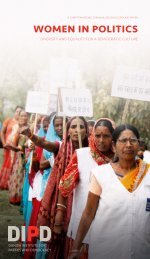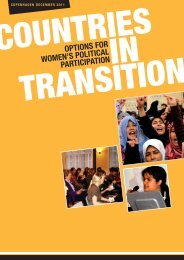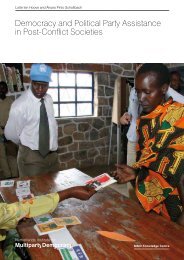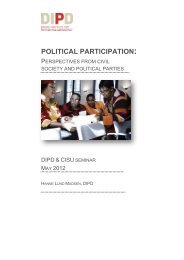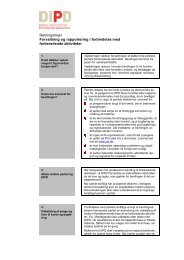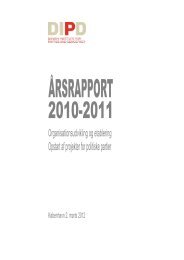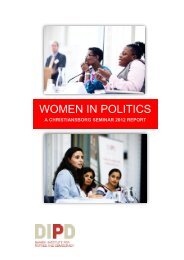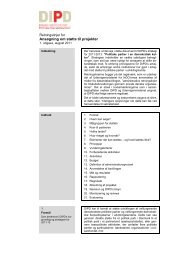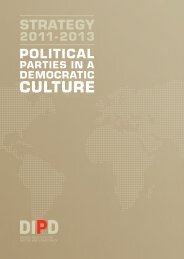Political Parties in Africa: Challenges for Sustained Multiparty
Political Parties in Africa: Challenges for Sustained Multiparty
Political Parties in Africa: Challenges for Sustained Multiparty
Create successful ePaper yourself
Turn your PDF publications into a flip-book with our unique Google optimized e-Paper software.
International Idea<br />
Colleen Lowe Morna’s paper addresses a largely miss<strong>in</strong>g aspect of women’s<br />
representation. That is the relationship between electoral systems and quotas <strong>for</strong><br />
women. She offers an <strong>in</strong>terest<strong>in</strong>g comb<strong>in</strong>ation of quotas and electoral systems<br />
with examples from Southern <strong>Africa</strong>. Morna shows that when the three dom<strong>in</strong>ant<br />
electoral systems <strong>in</strong> use <strong>in</strong> Southern <strong>Africa</strong>—(a) proportional representation,<br />
(b) constituency-based systems or FPTP, and (c) mixed PR and constituency-based<br />
systems—are comb<strong>in</strong>ed with the two possible types of quota (voluntary party quotas<br />
and constitutional or legislated quotas), the PR system is more suitable <strong>for</strong> the<br />
adoption of voluntary quotas (Morna 2004: 114). The evidence is corroborated <strong>in</strong><br />
Table 5.5.<br />
Julie Ball<strong>in</strong>gton takes a larger selection of cases, and uses data collected from 21<br />
<strong>Africa</strong>n countries show<strong>in</strong>g that ‘while countries with quotas <strong>in</strong> <strong>Africa</strong> average nearly<br />
17 per cent of women <strong>in</strong> politics (compared to n<strong>in</strong>e per cent <strong>in</strong> those without them),<br />
there are notable differences between them. The highest rate of representation on the<br />
cont<strong>in</strong>ent and <strong>in</strong> the world is to be found <strong>in</strong> Rwanda (48.8 per cent). Only two other<br />
countries, Mozambique and South <strong>Africa</strong>, have reached the 30 per cent target set by<br />
the Beij<strong>in</strong>g Plat<strong>for</strong>m <strong>for</strong> Action’ (Ball<strong>in</strong>gton 2004: 124). Ball<strong>in</strong>gton also illustrates<br />
that out of 16 countries with the highest level of women’s representation <strong>in</strong> politics<br />
worldwide (Rwanda, Sweden, Denmark, F<strong>in</strong>land, the Netherlands, Norway, Cuba,<br />
Spa<strong>in</strong>, Belgium, Costa Rica, Argent<strong>in</strong>a, Austria, South <strong>Africa</strong>, Germany, Iceland<br />
and Mozambique) 14 have adopted either closed or open List PR, and only four<br />
(Rwanda, Belgium, Costa Rica and Argent<strong>in</strong>a) have legislated quotas: the rest either<br />
have adopted voluntary political party quotas or have no quota (Ball<strong>in</strong>gton 2004:<br />
125).<br />
Table 5.5: Quotas <strong>in</strong> <strong>Africa</strong>: Electoral systems and the<br />
representation of women<br />
Country Electoral system Quota type Percentage<br />
ow women <strong>in</strong><br />
parliament<br />
Algeria List PR (closed lists) Voluntary party quota 6.2<br />
Botswana FPTP Voluntary party quota 17.0<br />
Burk<strong>in</strong>a Faso List PR (closed lists) Voluntary party quota 11.7<br />
Cameroon FPTP/list PR<br />
(closed lists)<br />
Voluntary party quota 8.9<br />
Côte d’Ivoire FPTP Voluntary party quota 8.5<br />
Djibouti Party Block Vote (PBV) 10% reserved seats 10.8<br />
Equatorial Gu<strong>in</strong>ea Majority TRS Voluntary party quota 5.0<br />
Party Structures and Internal Organization



